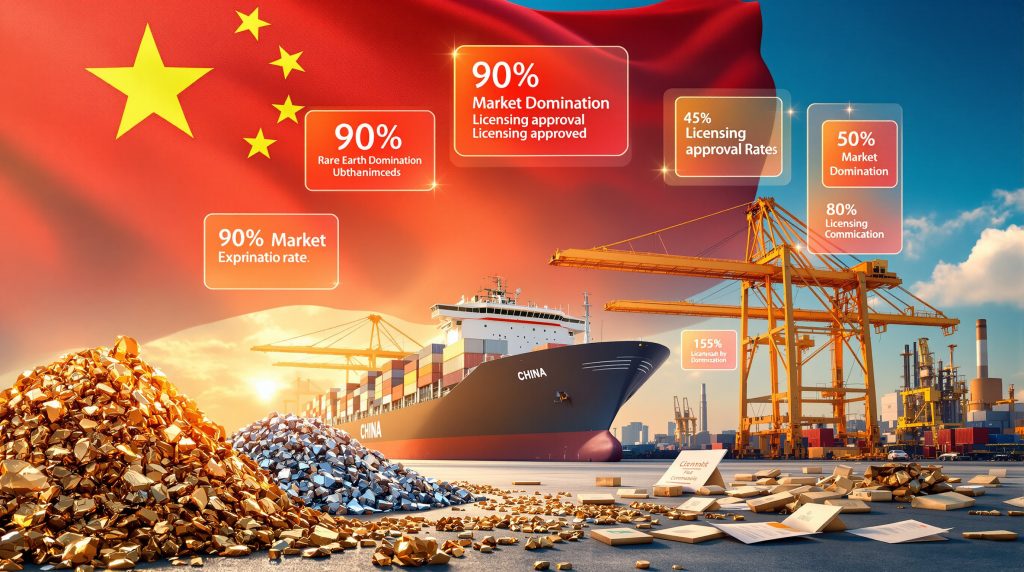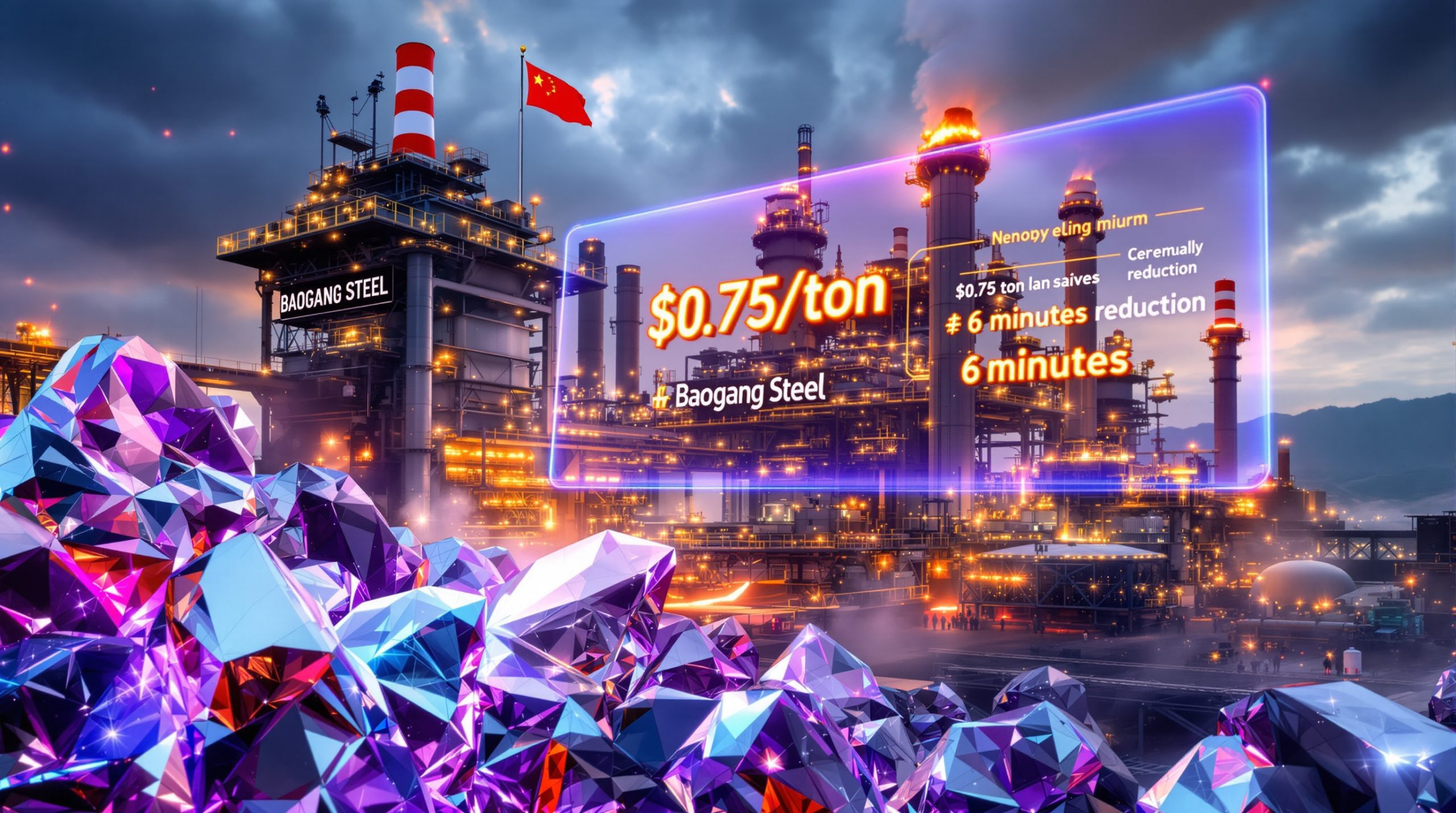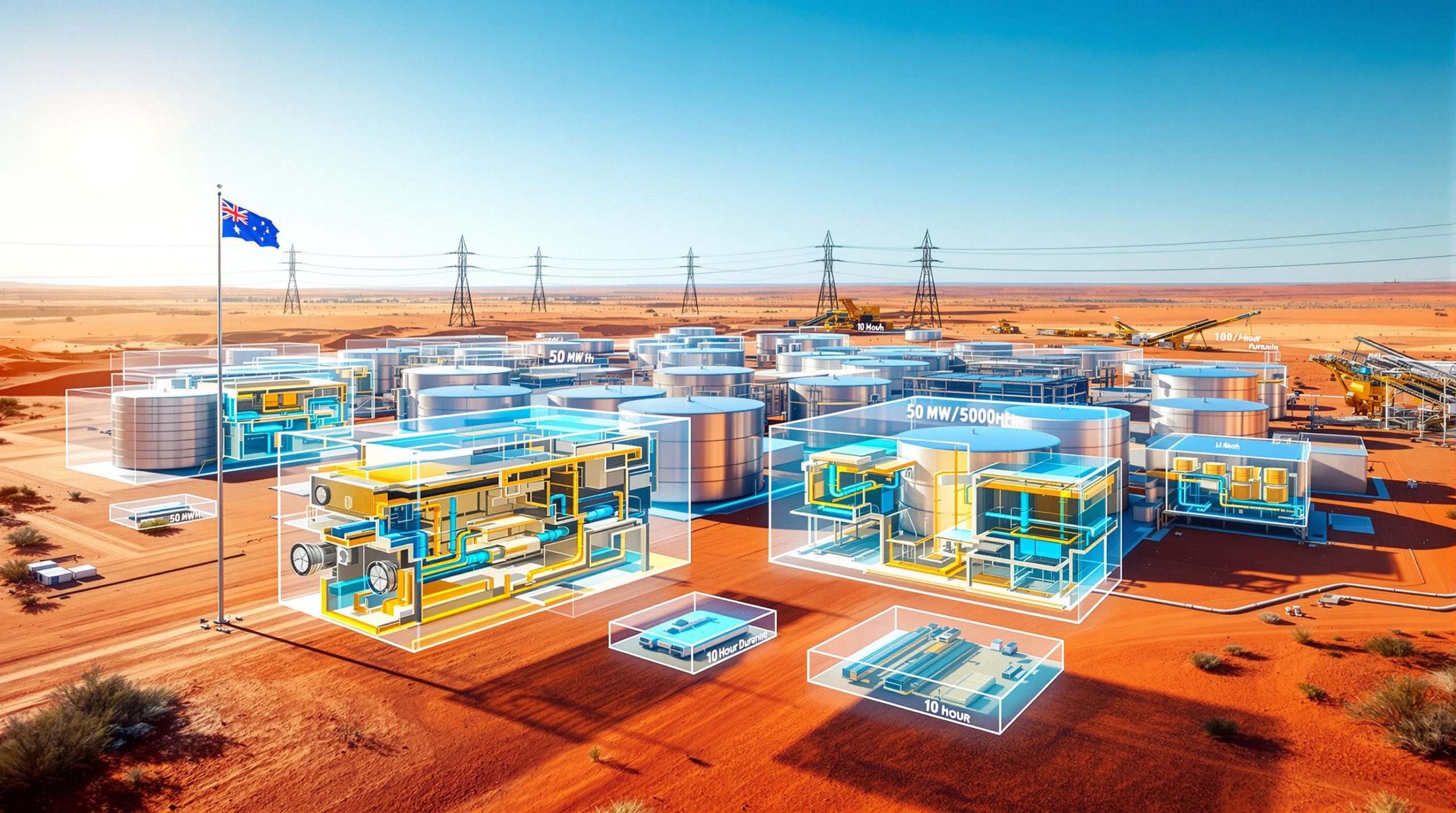Understanding China's Strategic Approach to Rare Earth Export Controls
China's dominance in the global rare earth market has transformed from a manufacturing advantage into a powerful geopolitical tool. The nation controls over 90% of the world's processed rare earth production, giving Beijing unprecedented leverage in international trade negotiations. This market position extends beyond raw materials to include rare earth magnets, where China maintains an equally commanding presence in global output. Furthermore, the implementation of China rare earth export rules has become increasingly sophisticated throughout 2025.
The strategic importance of these elements cannot be overstated. Rare earth metals are essential components in everything from smartphone displays to missile guidance systems, making them critical for both civilian technology and military applications. When supply chains are disrupted, the effects ripple through entire industries within weeks.
The Evolution From Simple Licensing to Comprehensive Trade Restrictions
Beijing's approach to rare earth export controls has undergone significant transformation throughout 2025. The system began with basic licensing requirements in April 2025 but evolved into a comprehensive regulatory framework by October of the same year. This progression reflects China's calculated escalation of trade policy tools in response to broader geopolitical tensions.
The licensing framework requires exporters to obtain permits for every cargo shipment, creating bottlenecks at critical points in the supply chain. Unlike production quotas that limit manufacturing capacity, these export controls concentrate regulatory power at shipping ports and border crossings, allowing Chinese authorities to maintain tight oversight of where rare earth materials ultimately end up.
Why China Holds 90% Market Dominance in Processed Rare Earths
China's overwhelming market share in processed rare earths stems from decades of strategic investment in refining and separation technologies. While other countries possess significant rare earth deposits, China developed the industrial infrastructure necessary to transform raw ores into the purified materials required by manufacturers.
The processing advantage extends throughout the supply chain. Chinese facilities handle the complex chemical separation processes that isolate individual rare earth elements from mixed concentrates. This technical expertise, combined with lower environmental compliance costs and government subsidies, created competitive advantages that proved difficult for Western companies to match.
What Are the Current Export Rules China Has Implemented?
April 2025 Initial Control Framework
The foundation of China's current rare earth export restrictions was established in April 2025 with the introduction of mandatory licensing requirements. This initial framework transformed what had previously been a relatively open export market into a tightly controlled system requiring government approval for all shipments.
Table: Key Elements of China's Rare Earth Export Licensing System
| Control Element | Scope | Impact Level |
|---|---|---|
| Mandatory Licensing | All rare earth shipments | High |
| Processing Timeline | 30-60 days per application | Medium |
| Documentation Requirements | Customer verification, end-use certificates | High |
| Approval Rate (EU firms) | 50% of 2,000 applications | Medium |
European Union companies have submitted approximately 2,000 applications since the April implementation, with just over half receiving approval. This 50% approval rate suggests either strict compliance requirements or deliberate supply management, though Chinese officials have not clarified the specific criteria driving approval decisions.
The documentation requirements represent a significant burden for both Chinese exporters and international buyers. Companies must now provide detailed customer verification and end-use certificates, requiring disclosure of downstream applications and final destinations for rare earth materials.
October 2025 Expanded Restrictions and Extraterritorial Reach
The October 2025 expansion significantly broadened the scope of China rare earth export rules. These enhanced restrictions introduced extraterritorial provisions, extending Chinese regulatory authority beyond its borders to cover foreign-made products containing Chinese rare earth materials.
The expanded framework includes provisions targeting companies with connections to defence and semiconductor applications. Firms operating in these sectors face additional scrutiny and potentially longer approval timelines, though specific processing times for sensitive applications remain undisclosed.
Re-export controls between third countries represent another significant development. Foreign companies that receive Chinese rare earth materials now face restrictions on selling those materials to other countries without Chinese approval, effectively extending Beijing's regulatory reach throughout global supply chains.
Seven Core Elements Plus Five Additional Materials Under Control
While specific details about which rare earth elements fall under different control categories remain limited, industry sources indicate that China has structured its restrictions around core strategic materials and additional specialised compounds. The seven core elements likely include the most commercially significant rare earths used in defence and technology applications.
The five additional materials probably encompass specialised rare earth compounds or processing intermediates that are critical for specific manufacturing processes. These materials may include rare earth oxides, refined alloys, or other value-added products that represent higher-margin segments of the supply chain.
How Do These Rules Impact Global Supply Chains?
Automotive Industry Disruptions and Production Halts
The automotive sector experienced the most immediate and visible impact from China's rare earth export restrictions. In May 2025, supply shortages brought significant portions of the automotive industry to a standstill, highlighting the vulnerability of Western manufacturing to Chinese export controls.
Modern vehicles require rare earth elements for multiple critical components:
• Electric vehicle motors and batteries
• Advanced driver assistance systems
• Infotainment displays and electronics
• Catalytic converter technologies
• Hybrid powertrain components
The production halts demonstrated how quickly rare earth supply disruptions can cascade through complex automotive supply chains. Even temporary shortages forced manufacturers to reduce production schedules and delay new model launches, creating ripple effects that extended to dealerships and consumers.
Defence and Technology Sector Vulnerabilities
Defence contractors face particular challenges under China's export control regime. Military applications typically require high-purity rare earth materials with specific performance characteristics, making substitution extremely difficult in the short term.
Critical defence applications include:
• Guided missile systems
• Radar and communications equipment
• Night vision devices
• Precision-guided munitions
• Electronic warfare systems
The technology sector confronts similar supply chain vulnerabilities, particularly in semiconductor manufacturing and consumer electronics production. Companies producing smartphones, computers, and advanced electronic devices depend on rare earth elements for displays, speakers, motors, and magnetic components.
European Union Response: 50% Application Approval Rate Analysis
The European Union's experience with China's licensing system provides insight into the practical implementation of the export controls. Of the 2,000 applications submitted by EU firms since April 2025, approximately 1,000 have received approval, representing a 50% success rate.
This approval rate raises several important questions:
• Whether rejected applications failed to meet documentation requirements
• If China is implementing informal quotas to limit export volumes
• Whether approval rates vary by industry or end-use application
• How processing times differ between approved and rejected applications
The relatively long processing timeline has created additional challenges for European manufacturers accustomed to just-in-time supply chain management. Companies must now build larger inventory buffers and plan procurement activities months in advance to accommodate licensing delays. Additionally, concerns about antimony shortage risks have further complicated supply chain planning.
What Changes Are Coming Under the Trump-Xi Agreement?
One-Year Suspension of October 2025 Controls
Following diplomatic negotiations between Presidents Donald Trump and Xi Jinping, China announced a one-year suspension of the expanded restrictions implemented in October 2025. This suspension represents a significant development in US-China trade relations, though its practical impact remains limited in scope. Consequently, Trump's critical minerals order may influence future negotiations.
Table: Comparison of Suspended vs. Active Controls
| Control Type | Status | Timeline | Coverage |
|---|---|---|---|
| October 2025 Restrictions | Suspended | 12 months | Defence/semiconductor users |
| April 2025 Core Rules | Active | Ongoing | All rare earth exports |
| New General Licenses | In Development | End of 2025 | Streamlined applications |
The suspension specifically targets the October 2025 enhancements while leaving the foundational April 2025 licensing system intact. This means that mandatory licensing requirements continue for all rare earth exports, maintaining the basic control framework established earlier in the year.
Companies in defence and semiconductor sectors may benefit most from the suspension, as these industries faced the strictest scrutiny under the October expansion. However, they still must navigate the underlying licensing requirements that remain in effect.
General Licensing Framework Under Development
Chinese officials have begun designing a new general licensing system that could streamline the approval process for certain categories of exports. The framework under development would allow exporters to apply for broader permits covering multiple shipments over extended periods.
Key features of the proposed general licensing system include:
• Twelve-month validity periods for approved licenses
• Higher volume allowances compared to individual shipment permits
• Streamlined documentation requirements for qualifying applications
• Enhanced customer verification procedures
Companies are currently preparing documentation packages that will require more detailed information from their customers. Chinese authorities expect to provide additional clarity about the general licensing framework by the end of 2025.
What the White House Claims vs. Chinese Ministry Reality
A significant discrepancy exists between public statements from the White House and private communications from Chinese officials regarding the scope of export control changes. The White House has characterised the general licensing system as effectively ending China's rare earth export controls.
However, Chinese officials privately indicate a more limited interpretation of the changes. They emphasise that the April 2025 licensing framework remains fully operational and that general licenses will not eliminate export oversight. This disconnect suggests potential misalignment in expectations between the two governments.
The disagreement centres on whether general licenses represent a fundamental policy shift or merely administrative streamlining. Chinese sources suggest that implementation could take several months, contradicting more optimistic timelines suggested by US officials.
Which Industries Face the Greatest Export Restriction Risks?
Defence Contractors and Military Applications
Defence contractors face the highest risk of licence denial under China rare earth export rules. Industry sources indicate that general licenses will be more difficult to obtain for users associated with defence or other sensitive applications, maintaining strict oversight of military-related exports.
Military applications requiring rare earth elements include:
• Precision guidance systems
• Electronic warfare equipment
• Communications technology
• Sensor and detection systems
• Advanced materials for weapons platforms
The dual-use nature of many rare earth applications complicates the approval process for defence contractors. Components that have both civilian and military applications may face additional scrutiny, even when intended for non-military use.
Semiconductor Manufacturing Dependencies
Semiconductor manufacturers represent another high-risk category for export restrictions. These companies require ultra-pure rare earth materials for chip production processes, making quality and consistency critical factors that limit sourcing flexibility.
Semiconductor applications include:
• Advanced chip manufacturing
• Memory device production
• Processor fabrication
• Specialised electronic components
• Research and development activities
The long lead times associated with semiconductor development create additional vulnerability to supply disruptions. Companies typically plan production schedules months or years in advance, making it difficult to adapt quickly to changing export approval conditions.
Clean Energy Technology Production Chains
Clean energy manufacturers face complex challenges under China's export control regime. While governments worldwide prioritise renewable energy development, China rare earth export rules could potentially slow clean energy technology deployment. Furthermore, the critical minerals energy transition remains a key priority despite these challenges.
Critical clean energy applications include:
• Wind turbine generators
• Electric vehicle motors
• Solar panel components
• Energy storage systems
• Grid infrastructure equipment
The tension between climate goals and trade policy creates difficult decisions for both Chinese regulators and international manufacturers. Balancing environmental objectives with national security concerns requires careful consideration of which applications qualify for streamlined approval.
How Will the New General Licensing System Work?
Streamlined Application Process for Non-Sensitive Users
The proposed general licensing system aims to reduce administrative burden for companies engaged in non-sensitive applications. Rather than applying for individual shipment permits, qualifying exporters could obtain broader authorisations covering multiple transactions over extended periods.
Streamlined features may include:
• Single applications covering multiple shipments
• Longer validity periods reducing reapplication frequency
• Standardised documentation packages
• Faster processing times for routine applications
• Higher volume thresholds for individual licenses
Chinese authorities indicated they expect to provide additional details about qualification criteria and application procedures by the end of 2025. Companies are currently preparing documentation packages in anticipation of the new system's launch.
Enhanced Documentation Requirements for Customer Verification
Despite streamlining certain aspects of the licensing process, the new system will maintain or potentially expand documentation requirements related to customer verification. Exporters will need to provide more detailed information about their customers and intended end-uses.
Enhanced documentation may include:
• Detailed customer profiles and business descriptions
• End-use certificates with specific application details
• Supply chain mapping showing downstream distribution
• Regular reporting on actual vs. planned shipments
• Compliance certifications from receiving companies
These requirements reflect China's intention to maintain oversight of where rare earth materials ultimately end up, even under a more streamlined licensing framework.
Twelve-Month Validity Periods and Higher Volume Allowances
General licenses under the proposed system would remain valid for twelve months, significantly longer than individual shipment permits. This extended validity period would allow companies to plan procurement activities with greater certainty and reduce administrative overhead associated with frequent reapplication.
Higher volume allowances could enable larger transactions under single permits, potentially reducing per-unit compliance costs for exporters and importers. However, specific volume thresholds and calculation methodologies have not been disclosed.
Companies operating in multiple markets may particularly benefit from the extended validity periods, as they could potentially use single licenses to cover shipments to various international customers over longer timeframes.
What Does This Mean for Companies Outside China?
50% Ownership Rule and Unreliable Entity List Implications
Foreign companies must navigate complex ownership and relationship requirements under China's rare earth export controls. The regulatory framework includes provisions that could affect companies based on their ownership structure, business relationships, and customer base.
Companies face particular scrutiny if they:
• Have significant government contracts or defence relationships
• Operate in industries deemed sensitive by Chinese authorities
• Maintain business relationships with companies on entity lists
• Participate in research activities related to strategic technologies
• Have ownership structures involving certain government entities
The extraterritorial reach of China's controls means that companies outside China may find themselves subject to Chinese regulations even when using rare earth materials obtained through third-party suppliers. For instance, China's new restrictions on rare earth exports threaten US defence supply chains significantly.
Extraterritorial Jurisdiction Over Foreign-Made Products
China's October 2025 expansion introduced extraterritorial provisions that extend regulatory authority beyond Chinese borders. Foreign companies using Chinese rare earth materials in their products may find themselves subject to Chinese export control requirements.
Extraterritorial provisions may affect:
• Products containing Chinese rare earth materials
• Technology transfers involving rare earth applications
• Joint ventures or partnerships with Chinese companies
• Research collaborations using Chinese rare earth supplies
• Subsidiary operations in multiple countries
These provisions create compliance challenges for multinational companies that must now consider Chinese regulations alongside their home country requirements and international trade law obligations. Moreover, the US‑China trade war impact continues to complicate international business relationships.
Re-export Controls Between Third Countries
The re-export control provisions represent one of the most significant changes in China rare earth export rules. Companies that receive Chinese rare earth materials may face restrictions on selling those materials to third countries without Chinese approval.
Re-export controls could affect:
• Trading companies that distribute rare earth materials
• Manufacturers that incorporate rare earths into finished products
• Research institutions sharing materials with international partners
• Supply chain intermediaries handling multiple customer relationships
• Companies operating in multiple geographic markets
These controls effectively extend Chinese regulatory authority throughout global supply chains, creating new compliance obligations for companies that previously operated independently of Chinese oversight.
Strategic Implications for Global Rare Earth Markets
China's Economic Leverage in Trade Negotiations
China's rare earth export controls have emerged as Beijing's most potent source of leverage in trade negotiations with Western governments. The combination of market dominance and strategic importance gives China significant influence over international economic and political discussions.
The leverage operates on multiple levels:
• Direct impact on manufacturing supply chains
• Influence over defence and national security capabilities
• Effect on clean energy transition timelines
• Pressure on technology development programmes
• Bargaining power in broader trade negotiations
The May 2025 automotive industry disruptions demonstrated the speed with which rare earth supply restrictions can translate into economic pressure on Western governments and industries.
Western Efforts to Develop Alternative Supply Sources
Western governments and companies have accelerated efforts to develop alternative rare earth supply sources in response to China's export controls. These initiatives span the entire supply chain from mining to processing to manufacturing. Additionally, the European CRM facility represents a significant step towards supply chain diversification.
Alternative supply development includes:
• Mining projects in Australia, Canada, and the United States
• Processing facilities outside of China
• Recycling programmes for rare earth materials
• Substitution research for critical applications
• Strategic stockpile development
However, developing alternative supply chains requires significant capital investment and time. Most projects will need several years to achieve commercial production at scales that meaningfully reduce dependence on Chinese supplies.
Long-term Shifts in Critical Mineral Dependencies
The rare earth export controls are accelerating broader shifts in how countries and companies think about critical mineral dependencies. The experience has highlighted vulnerabilities that extend beyond rare earths to other strategic materials.
Long-term implications include:
• Increased government involvement in supply chain security
• Higher inventory costs as companies build strategic buffers
• Accelerated development of domestic processing capabilities
• Greater emphasis on supply chain diversification
• Integration of supply security into national security planning
These shifts represent fundamental changes in how global markets operate, moving away from pure efficiency optimisation toward resilience and security considerations.
Looking Ahead: Future of China's Rare Earth Strategy
Potential for Further Restrictions or Relaxation
The future trajectory of China's rare earth export policies remains uncertain, with potential for both tightening and relaxation depending on broader geopolitical developments. The one-year suspension of October 2025 controls provides a window for diplomatic progress, but also creates deadline pressure for longer-term solutions.
Factors that could influence future policy direction include:
• Progress in US-China trade negotiations
• Western success in developing alternative supply sources
• Changes in global demand for rare earth materials
• Domestic Chinese industry considerations
• International response to export control policies
Chinese policymakers must balance the strategic advantages of export controls against potential long-term costs, including reduced market share and accelerated efforts to develop competing supply sources. The IEA's commentary highlights how supply concentration risks become reality with new export controls.
Impact on Global Clean Energy Transition Timeline
China's rare earth export controls could potentially affect the timeline for global clean energy transitions, given the critical role of rare earth materials in renewable energy technologies. Wind turbines, electric vehicles, and grid infrastructure all depend on rare earth components.
Potential impacts on clean energy deployment include:
• Delayed manufacturing of wind turbines and solar equipment
• Higher costs for electric vehicle production
• Slower development of energy storage technologies
• Reduced availability of grid modernisation equipment
• Increased emphasis on rare earth recycling and substitution
The tension between climate objectives and trade policy creates complex challenges for governments worldwide. Balancing environmental goals with supply security requirements may necessitate difficult policy trade-offs.
Western Strategic Response and Supply Chain Diversification
Western governments are implementing comprehensive strategies to reduce dependence on Chinese rare earth supplies while maintaining industrial competitiveness. These efforts involve collaboration between governments, industry, and research institutions across multiple countries.
Strategic response elements include:
• Government funding for domestic rare earth projects
• International partnerships for supply chain development
• Research programmes focused on substitution and recycling
• Strategic stockpile policies
• Trade agreements incorporating critical mineral provisions
The success of these initiatives will largely determine whether China's current market dominance persists or whether more balanced global supply chains emerge over the next decade.
Disclaimer: This analysis is based on publicly available information and industry reporting. Rare earth market conditions, trade policies, and geopolitical relationships continue to evolve rapidly. Companies should consult current official sources and qualified legal and trade advisors before making business decisions related to rare earth supply chains or export control compliance.
Ready to Invest in the Next Major Mineral Discovery?
Discovery Alert instantly alerts investors to significant ASX mineral discoveries using its proprietary Discovery IQ model, turning complex mineral data into actionable insights. Understand why historic discoveries can generate substantial returns by visiting Discovery Alert's dedicated discoveries page, showcasing historic examples of exceptional outcomes, and begin your 30-day free trial today to position yourself ahead of the market.




